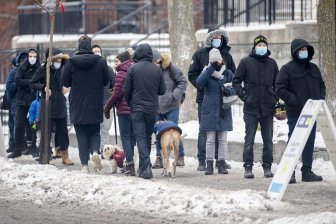With temperatures fluctuating from cold to mild over the past few days, Saskatchewan residents are being reminded to watch out for ice dams on their property.
SGI Canada says the freeze-thaw cycle during the winter months creates ideal conditions for condensation and ice damming.
The results can cause damage to walls, ceilings and insulation, not to mention it can lead to mold issues down the road.
“The snow becomes a layer of insulation on your roof, which warms up the air in your attic. If you have poor attic ventilation, the warm air can lead to condensation,” SGI Canada explains in a news release.
“This also causes the snow to melt and roll down to the edge of the roof and the soffits. Unless the melted snow can drain properly, it’ll freeze and build up over time, creating ice dams.”
Read more:
‘Steering before braking’ — Saskatchewan Safety Council offers winter driving course
SGI Canada says water will work its way under shingles and eventually into the attic if ice dams spread up the roof.
Over time, wet surfaces attract mold, which causes breathing problems and makes repairs much more expensive for homeowners.
However, condensation and ice damming problems can often be spotted and hopefully be prevented by removing as much snow as possible from the roof, according to SGI Canada.
Read more:
Extreme cold causing problems for Saskatchewan property owners
There are a few ways in which ice dams can be spotted, including icicles on the roof, dark-coloured icicles, new water stains on ceilings, melted snow on the roof or mounds of ice running along the bottom edge of the roof.
Below are five tips offered by SGI Canada to prevent ice damming on your home:
- Get the snow off your roof: You should always keep the snow load on your roof to a minimum to prevent it from causing an ice dam. We don’t recommend climbing on the roof yourself. Use a roof rake or hire a professional to clear away excess snow. Read our tips for using a roof rake.
- Try and find the vent on your roof: When you find the vent, make sure to clear the snow and ice out of it – not just the snow on top of it.
- Clear your gutters and downspouts: Melting snow and icy water need somewhere to go. Clean leaves out of your downspouts and gutters in the fall and try to get rid of as much ice, snow and gunk as possible throughout the winter. Break off any icicles that build up around the roof of your home.
- Keep the air moving in your attic: Your attic needs good insulation and ventilation. Without it, the heat inside your home will leak into the attic and cause the snow on the roof to melt. We recommend bringing in a roofing contractor to make sure the airflow is working properly.
- Make sure fans and vents are sealed: Many homes have exhaust fans, air ducts, chimneys, attic hatches and pipes – and many of these are vented into the attic. They’re designed to move air flow properly, but if they aren’t sealed, extra air can escape around them. We recommend going into your attic and checking the seals. If they’re leaky, you can fix them yourself or hire a professional to take care of it for you. Good seals will save you money by keeping your house warmer and preventing your furnace from working harder to heat it.
© 2022 Global News, a division of Corus Entertainment Inc.
Reference-globalnews.ca

